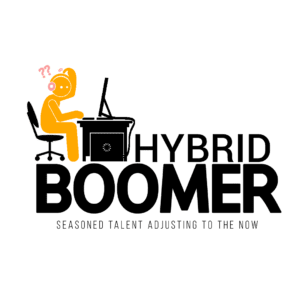To the Hybrid Boomer – I appreciate your support.
What would the return to work look like after the COVID pandemic restrictions were lifted? What was initially thought of as a hybrid work model has looked more like a remote arrangement. Now companies are going back to further define the return as a flexible work model that combines in-office, remote, and anywhere options for employees. Employees can choose to work wherever they are most productive, but usually with a requirement to come on-site one or two days a week.

The transition to the original model was a difficult one for many. But employees made the adjustment and settled in to mainly working out of their homes. Employees are now faced with another transition, which is the return to regular workdays in a company provided facility for a couple of those days.
They are faced with getting dressed for work again!
After over two years of pajamas, sweats, and house shoes or flip flops, what to wear now?
Are the clothes worn two years ago still good or are they outdated? Factoring in gas prices, lunch money, and the commute, the return could even be financially painful.
Further, is the space once occupied on-site ready for employees to come back on a regular cadence? Do the equipment and work supplies taken home come back with the return to the office?
Employees Are Concerned
Some employees are expressing concerns about coming back even part-time, especially since it has been proven that work from home is productive. A Gallup poll estimates that over 70 Million US Workers can do their job working remotely. In fact, a Microsoft Work Trends Study that surveyed 20,000 people across 11 countries found that 87% of employees say that they are actually more productive when they work remotely or in a hybrid setup.
Employers Want The Return
Yet, company executives say that the return should be about people getting together for social reasons. They believe that a cultural breakdown happened during the pandemic and employees need to get back to seeing each other to collaborate face-to-face. But is it really about culture and socializing or could it be that employers do not believe that employees work as hard while working from home?

Either way, another Microsoft report suggests that the return under a hybrid work model can thrive if there is a culture of trust and flexibility.
But what about safety? COVID is not gone. Contained perhaps, but people are still getting sick from it. The CDC COVID Data Tracker still reports new cases and hospitalizations in the thousands. Even the flu is spiking. Masks mandates are pretty much gone!
Regardless, corporate executives have decided that in the best interest of maintaining a cohesive work environment the return must happen now. But is the risk of losing employees worth the return? Gallop suggests that the return could mean less employee engagement, burnout, and an increased desire by employees to just quit.
Employees believe that they do their best work from home because it positions them to also live their best life!
Show your pride in being a Hybrid Boomer – visit my online store.
If you enjoyed reading this article, click the button below to leave a donation to help support the site. I appreciate your visit!
Oh, and don’t forget to bookmark this site to come back often!

